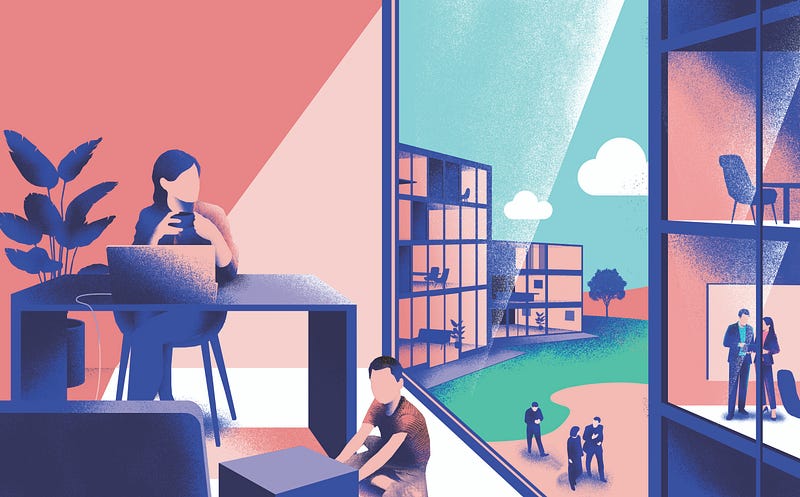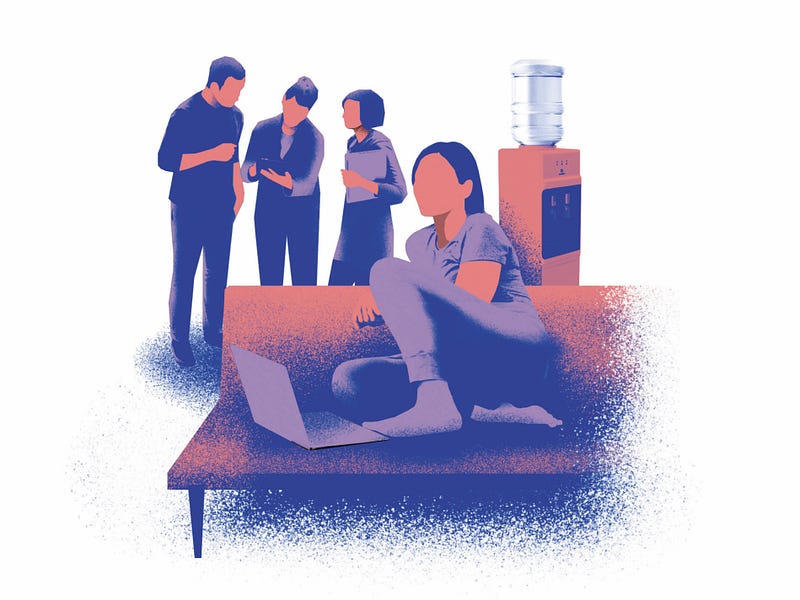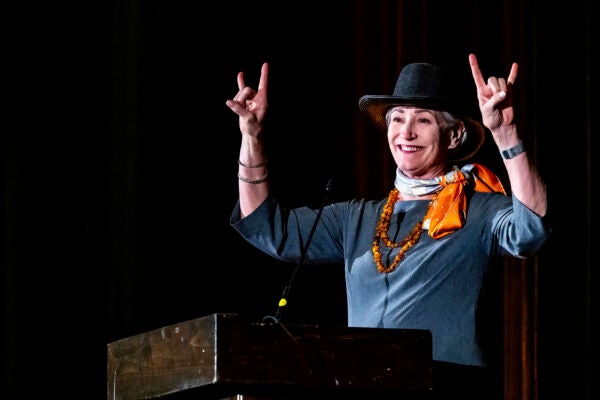Disrupted New World
How the pandemic is altering the way we do business, the office culture, and our work lives.
By Sharon Jayson | Illustrations by Mario Wagner

The business world was primed for disruption.
After all, everyone from the C-suite to the to the rank-and-file worker has long experienced technological changes in the workplace. It’s been clear that would only accelerate.
But no one was prepared for the sweeping disruptions brought on by the COVID-19 pandemic and how fast our lives and livelihoods would change. As WFH (work from home) became a well-worn abbreviation, the spread of what was once called “telecommuting” gave way to virtual everything.
While COVID-19 vaccination spurred back-to-office plans, the rise of a new disease variant, omicron, caused many businesses to take a step back, highlighting just how remote work continues to be an issue companies must navigate. Experts agree the pandemic has expedited acceptance of working from home and answered lingering questions about productivity. But as the end of Pandemic Year Two approaches in March, companies must decide: Who returns to the office, and when? What does the office environment look like? How do we balance the face-to-face return with remote employees and keep everyone engaged?
Rapid transformation is also underway in workplace culture, with evolving demands from younger workers and women who bore much of the burden of child-rearing and schooling during pandemic closures. Although many lost jobs during the pandemic, others are quitting, leaving companies scrambling to attract and retain talent. “It’s all about competition, both internally and externally,” says Mark Gibson, BBA ’81, CEO at JLL Capital Markets in Dallas. “For example, if JP Morgan states we are a work-from-work culture, what will Bank of America, Wells Fargo and others do? It is not practical to believe a company will create a desirable culture, mentor, and train their people, thereby increasing productivity, form important networks of contacts, and create new products and thought leadership in a work- from-home environment. The U.S. business community has done a great job of treading water during the pandemic but has found it very difficult to grow or advance a business in a work-from-home construct.”

Texas McCombs faculty members and alumni who ponder these questions offer their insights into the future of work. As we move forward into this uncharted territory, here are seven things to know:
1. Remote work is here to stay.
Whether it’s called telecommuting, telework, remote work, or simply WFH, the concept has evolved from its start in the 1970s as a perk for a seemingly lucky few. The pandemic made remote work the standard for everyone who could. Because it has been widely adopted and is lasting longer than expected, McCombs experts expect it to continue but not without presenting a few wrinkles.
“Before the pandemic, folks who worked virtually were allowed to because they were top performers, or it was a way to attract and pay them,” says David Harrison, a McCombs professor of management who researches virtual work. “COVID pushed that over the edge where enough folks did it so that we’re not going back. It’s going to change the workplace fundamentally if it hasn’t already.”
WFH benefits have been studied in recent decades, including a 2007 research paper published in the Journal of Applied Psychology that Harrison co-authored.
“Telecommuting has a clear upside: small but favorable effects on perceived autonomy, work-family conflict, job satisfaction, performance, turnover intent, and stress. Contrary to expectations in both academic and practitioner literatures, telecommuting also has no straightforward, damaging effects on the quality of workplace relationships or perceived career prospects,” says the study.
Research on remote work published in 2020 in the Harvard Business Review underscores those benefits, but the authors, including Andrew Brodsky, a McCombs assistant professor of management, warn it could undermine efforts to help new employees adapt to the office culture. The article also suggests the positive results that accrued when everyone was working remotely could evaporate if some workers are allowed to remain remote full time while others are subjected to pandemic protocols in the office.
Mark Gibson, BBA ’81, CEO at JLL Capital Markets in Dallas, says he favors offering workers flexibility but believes in-person work has strong staying power.
“We’re in the middle of space planning for the largest corporations in America,” Gibson says of JLL, a Fortune 500 global commercial real estate services company that employs more than 92,000 workers in over 80 countries. Before the pandemic, offices were getting “too dense and productivity was going down. Individuals didn’t like it. Fewer people per square foot was already occurring, but the pandemic accelerated it across the board.”
So, as offices figure out their space needs, WFH opportunities will depend to some extent on geography, with workplaces that have long commutes more likely to have more hybrid work than those where commuting is less of an issue, Gibson says.
“We already had a hybrid model pre-COVID,” he says. “It will vary by sector. It can be efficiently done in a remote environment for a period of time on certain days of the week. But the vast majority of industries in America are going to need collaboration for a host of reasons.”
As he sees it, in-person work fosters deeper collaboration, which is essential not only to promote camaraderie but company loyalty. He adds that people in their mid-30s who want a career, not just a job, will have to come back to the office to get promoted.
2. Commercial real estate is coming back.
The pandemic wreaked havoc on the country’s office space and is still affecting the rental market. From small businesses to large corporations, many executives are creating return-to-the-office policies that include WFH days, how many employees to allow on site at a time, and how to reconfigure space.
In fall 2021, McCombs experts recognized signs the commercial real estate market was coming back, with some sectors faring better than others.
Gibson, a fall 2021 McCombs Hall of Fame inductee, says apartments and industrial space, such as self-storage, warehouses, and science and data centers, did well during the pandemic, with retail, hospitality, and office sectors suffering. But now, he says, capital is starting to “rotate into office, hospitality, and retail.”
Greg Hallman, senior managing director and lecturer in the Real Estate Finance and Investment Center at McCombs, says because he expects most companies to opt for a hybrid model of remote and in-office work, companies won’t be able to reduce office space. “Hybrid models that include any day in which everyone is in the office don’t allow firms to cut space like they would be able to if they had no days in which everyone was there.”
In fact, Mark Roberts, former executive director of the Texas Real Estate Center, suggests that the calculation for office square footage per person may actually increase.
“Whereas right now the average is somewhere around 150 to 170 square feet per employee, I could see tenants planning for 20% more square feet per employee to spread out for health and wellness reasons,” he says.
A McCombs survey in 2020 found that although just 21% of employees worked from home one to three days per week before COVID-19, that is expected to rise to 75% after the pandemic.
Roberts says increasing employee workspace is a reversal of the open office trend of the past few decades that often was “done to pack more people into square feet of space as a cost reduction.” The pandemic is shifting that priority.

3. Office space is being transformed.
COVID-19 altered our physical work environment, adjusting our homes to accommodate the needs of our office. Offices that sat mostly vacant are being transformed as companies want employees to feel safe returning. They’re improving air circulation, increasing space between desks, adding areas to collaborate, and adopting “hot seats” or “hoteling,” in which employees reserve office desk space instead of having a dedicated spot.
For some, “there will not be a desk where you own the desk and your personal life is displayed with photos and what nots,” says Bukky Akinsanmi, an assistant professor of management at McCombs who has master’s degrees in architecture and environmental design. “A portion of the office is set up for the time you’re in the office, and a good proportion of workers will not be required to come in every day. Workers will more or less play musical chairs at work.” That comes with a cost, Akinsanmi says, because “the ability to personalize space or claim it with territoriality is critical to humans. When you have employees not able to claim a particular spot as theirs, it can have implications on their ability to identify with the organization. It’s very critical to organizational commitment and job satisfaction and helps you retain valuable employees.”
At the same time, younger workers are demanding more home-like office spaces with couches, tables, and chairs, adding to spacing demands. She also recommends design strategies to help air quality in the kitchens and reduce odors, in addition to noise-masking technology in ceilings.
“Where deep thinking and problem solving need to occur, firms should have private carrels: single-user spaces with computers and docking stations where they can focus for a few hours,” Akinsanmi says. “Analyzing the value creation process, as well as identifying what is critical to success and the characteristics of its work, helps companies to create or modify physical workspaces to suit those processes.”
Roberts says policies that determine how individuals use office space could inadvertently affect relationships and collaboration.
“The jury is still out on whether those strategies are going to help the productivity of a company,” he says. “You think about a company that’s got different divisions — marketing, production divisions. Those teams typically work together in those disciplines. The hoteling concepts can be beneficial for cross-departmental interaction, but will those people lose connection with their own internal teams?”
4. Remote work is reshaping office culture.
While working from home enabled continued employment during the pandemic, the fact that remote work is just that — remote — creates new challenges for employee relations and office culture.
“When we all initially went home in the spring of 2020, we were getting onto Zoom calls with people we had established relationships with. We have burned through that time now,” says Hallman, the lecturer in real estate finance at McCombs. “Firms are going to start to notice that doesn’t work as well to put people on Zoom calls that never had that personal relationship.” A new study of the pandemic’s strain on social ties co-authored by Harrison, the McCombs professor of management, published in September in the Journal of Applied Psychology. The research finds that people reduced their workplace social circles and scaled back close friendships. He says social support that people usually seek when stressed was not there because everyone had the same pandemic threat. “That is, we tended to withdraw from many of our relationships, even when they were about emotional backup,” he says.
Experts say companies must carefully approach remote work during the coming year to prevent fraying relationships and maintain an office culture that attracts workers.
Brodsky warns organizations to “avoid unintentionally creating two tiers of employees.” “If a manager can only truly observe those in-person employees working hard, then the virtual employees may be evaluated less favorably,” he says. Further, many workplace relationships, on which promotions are based, are built around spontaneous interactions that occur in the workplace. As a result, virtual employees may miss out on relational opportunities that lead to career advancement.”
5. Millions are calling it quits.
Staying employed was an immediate objective for workers when the pandemic hit, but the drawn-out WFH period has spurred a change of heart for some. Reflecting on everything from work-life balance to whether the job is the right fit, some have concluded it’s time for a change.
On January 4, the Bureau of Labor Statistics reported that a record 4.5 million people quit jobs in November — the highest monthly ratio of people quitting their jobs relative to total employment since the bureau started collecting the data in 2000. Those in lower-paying jobs have more opportunities now to seek higher wages, while others seek more flexibility with a new company.
An August Bankrate survey shows that 55% of American workers say they’re somewhat or very likely to seek a new job in the next year. An American Psychological Association survey released in October reflects the trend, with 44% of 1,500 workers saying they intend to look for a new job in the next year, up from 32% in 2019.
To improve employee well-being and possibly reduce turnover, 87% thought their employer could help by offering flexible hours (34%), granting paid time off (30%), and encouraging breaks during the workday (30%).
S. Craig Watkins, named the new director of the IC2 Institute in January, said at the Texas McCombs “The Future of Work: It’s a Brave New World” virtual event in September that his research on millennials and Gen Z suggests they’re “much more likely than prior generations to engage in what we might call ‘occupational switching,’ to switch careers or experiment with new careers.”
Facing pressure to hold and attract employees, some companies are expanding benefits and offering sign-on bonuses.

6. Companies seek to curb an exodus of women.
The statistics are striking: almost 2 million fewer women are in the labor force than before the pandemic. According to a 2020 McKinsey report, 1 in 3 working mothers were considering leaving the workforce or reducing work time, citing child care as the major reason. Women with children younger than 18 also are having a slower return to the workforce, having dropped out as they juggled parenting and supervising Zoom schooling. Additionally, data reflects that up to 40% of U.S. day cares closed amid COVID-19 protocols.
Gay Gaddis, BFA ’77, who founded Austin advertising and digital marketing agency T3, says companies need to address these challenges. More than 25 years ago, the private spaces she provided allowed her new-parent employees to bring newborns to the office and directly care for them. Gaddis, a McCombs Hall of Fame inductee in fall 2021, says the same type of innovation is needed now. “If people go back to the office, they’ve got to find creative ways — especially for women — to deal with their families and their lives,” she says.
Gaddis was already thinking about ways to encourage executive leadership development for women before the pandemic. She proposed along with Lynn Utter, BBA ’84, a new, six-month program offered through Texas Executive Education that she’s co-teaching called Women Who Mean Business.
Another executive thinking about ways to help female leaders is Ayse McCracken, MBA ’12 and president of Ennovate Health Ventures, which consults with health systems and digital health startups.
In 2017, she founded the nonprofit Ignite Healthcare Network to help female executives shape the future of an industry where women comprise 75% of the workforce yet are only 13% of the CEOs, according to its website.
Working with female entrepreneurs across the country for her company’s steering committee during the pandemic, McCracken says, “You could hear the stress. It was very real for the young women leaders of our team.”
7. Business travel remains depressed.
The pandemic effectively halted business travel. Although leisure travel is returning, business travel remains slow.
Hallman says that of the pandemic’s consequences, fewer business trips may be the most lasting. “I’m more worried about investments we might have in hotels that cater to a lot of business travel. From looking at the change in value of business travel hotels — which are still down 10% to 15% from pre-COVID levels — it makes me worry about business travel coming back.” A Deloitte survey released in August found that one-third of companies expected to end 2021 using less than one-quarter of 2019 travel spending.
Gibson says technology “has allowed us to eliminate wear and tear on your body through travel either internationally or domestically for largely unnecessary reasons.”
He expects his commercial real estate services company to rethink the need for such non-client-oriented business travel.
“If it’s necessary to be in person, then go do it,” he says. “I’ve traveled a lot internationally, but it’s a real beating to travel to Asia or Europe. Does technology ever replace in person? No. But does it replace the frequency? And the answer is yes.”
Hallman is more optimistic that some sectors, particularly banking and finance, will welcome traveling again.
“I’ve heard from bankers that they don’t feel like they can rely on remote contact, including remote sales calls and pitches for new business, to effectively compete with banks making in-person sales calls and pitches,” he says. “Getting new business in the banking and financial sector involves developing a level of trust between the banks and the clients. It’s hard to establish trust over remote connections.”
Sharon Jayson is an Austin-based journalist who was a staff reporter for USA Today and the Austin American-Statesman. Her work has also appeared in The Washington Post, Time magazine, U.S. News & World Report, Kaiser Health News, and AARP.
This article appeared in the spring 2022 issue of McCombs magazine. Click on the link to see the full issue.
About this Post
Share:


